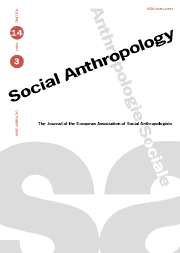Article contents
Morphologie traditionnelle de lasociété albanaise
Published online by Cambridge University Press: 01 February 1999
Abstract
Two categories of reference constitute the social organisation of Albanese society. The notion of fisi (‘lineage’) represents the first, which is typifying, segmentary and holistic, while the second, classifying, linear and individualising is represented in the notion of lisi i gjakut (‘tree of blood’). These categories do not oppose each other as both pertain to a common logic of patrilineal filiation. Unlike the segmentary regime, the linear one does not allow to account for the previous generations. Thus, when a large number of collateral parents acknowledge themselves as being part of a common ‘tree of blood’, they still have to qualify this through a second symbolic and hereditary marker which, from a vertical axis, will complete the lack of memory and/or of ramification. A fixation of the patronymic name in the broad sense - the transmissible family name - becomes then necessary. This ordered complementarity between the segmentary and the linear reveals itself as a sociological operator the hierarchical nature of which allows the transactional opening in strategic relations oriented towards the other.
- Type
- Research Article
- Information
- Copyright
- © 1999 Cambridge University Press
- 7
- Cited by


